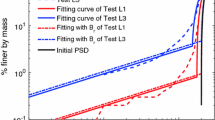Abstract
Analysis of the influence of thermal, mechanical, and electromagnetic actions on the stability of the granular structure of dispersion-hardened alloys with a uniform distribution of incoherent mobile particles of constant radius has been performed. It has been shown that of all parameters describing the process of interaction between the grain boundary and particles, only the relative mobility μ is a function of temperature. An expression for the relative mobility, universal for all metals, has been obtained in the approximation in which the particles in the crystal matrix participate in the diffusion motion according to the Geguzin model (volume flow mechanism). It has been shown that the influence of the test temperature on the relative mobility μ and, therefore, on the stability of the granular structure is determined by the ratio of the activation energy of grain-boundary migration H to the activation energy of particle motion Q.
Similar content being viewed by others
References
K. I. Portnoi and B. N. Babich, Dispersion-Hardened Materials [in Russian], Metallurgiya, Moscow (1974).
L. A. Marvina, V. B. Marvin, V. R. Karib’yants, and I. V. Neupokoeva, Prediction of stability of the granular structure of dispersion-hardened alloys under collective crystallization, Nauka Proizvodstvu, No. 4(42), 33–35 (2001).
L. A. Marvina and V. B. Marvin, Diffusion Processes and Degradation of the Structure in Metals [in Russian], Dal’nauka, Vladivostok-Blagoveshchensk (1996).
L. A. Marvina and V. B. Marvin, Conditions for the dragging of migrating grain boundary in an alloy with particles under primary recrystallization, Fiz. Metal. Metalloved., 88, No. 5, 11–20 (1999).
E. Rabkin, Zener drag in the case of anisotropic grain boundary energy, Scr. Materialia, 39, No. 12, 1631–1637 (1998).
B.-N. Kim and T. Kishi, Finite element simulation of Zener pinning behavior, Acta Materialia, 47, No. 7, 2293–2301 (1999).
N. V. Selivanov and I. V. Neupokoeva, On the influence of high temperatures on stability of the granular structure of dispersion-hardened alloys, Vestn. AGTU, No. 1(20), 31–34 (2004).
Ya. E. Geguzin and M. A. Krivoglaz, Motion of Macroscopic Inclusions in Solid Bodies [in Russian], Metallurgiya, Moscow (1971).
M. A. Shtremel’, Strength of Alloys [in Russian], Pt. 1, MISSIS, Moscow (1999).
S. S. Gorelik, Recrystallization of Metals and Alloys [in Russian], Metallurgiya, Moscow (1985).
V. A. Kulikov, N. M. Zaitseva, Yu. N. Kolobov, and L. S. Bushnev, Structure and Properties of Dispersion-Hardened Strengthened Nickel Alloys [in Russian], TGU, Tomsk (1986).
M. F. Ashby and R. H. Centamore, The dragging of small oxide particles by migrating grain boundary in copper, Acta Materialia, 16, No. 7, 1081–1088 (1968).
Author information
Authors and Affiliations
Additional information
__________
Translated from Inzhenerno-Fizicheskii Zhurnal, Vol. 78, No. 6, pp. 100–105, November–December, 2005.
Rights and permissions
About this article
Cite this article
Selivanov, N.V., Neupokoeva, I.V. Analysis of the influence of temperature and deformation on the stability of the granular structure of alloys containing second-phase particles. J Eng Phys Thermophys 78, 1149–1154 (2005). https://doi.org/10.1007/s10891-006-0047-8
Received:
Issue Date:
DOI: https://doi.org/10.1007/s10891-006-0047-8




